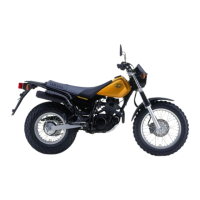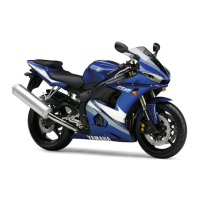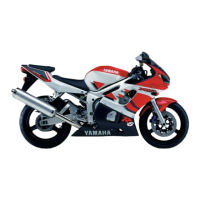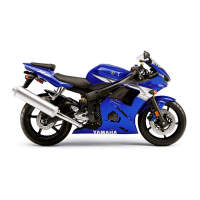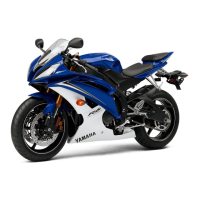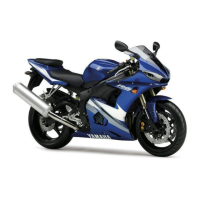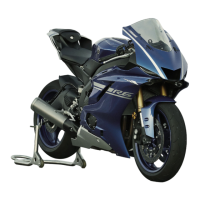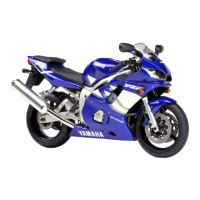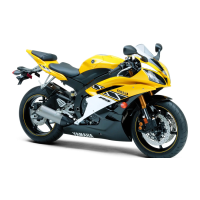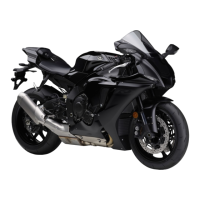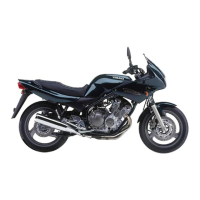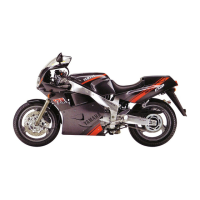
Do you have a question about the Yamaha 1999 YZF-R6 and is the answer not in the manual?
| Bore x Stroke | 65.5 mm x 44.5 mm |
|---|---|
| Compression Ratio | 12.4:1 |
| Ignition | Digital TCI |
| Transmission | 6-speed |
| Final Drive | Chain |
| Front Suspension | Telescopic fork |
| Front Brakes | Dual 298 mm discs |
| Front Tire | 120/60-ZR17 |
| Rear Tire | 180/55-ZR17 |
| Wheelbase | 1, 380 mm (54.3 in) |
| Seat Height | 820 mm (32.3 in) |
| Engine Type | liquid-cooled, DOHC, inline 4-cylinder |
| Rear Suspension | Single shock |
| Rear Brakes | 220mm disc |
| Fuel Capacity | 17 l (4.5 US gal) |
| Dry Weight | 169 kg |
Explains the structure and conventions of the service manual for easy navigation and understanding.
Provides a key to the various symbols used throughout the manual for quick reference.
Lists and illustrates specialized tools required for maintenance and assembly procedures.
Details the overall dimensions, weight, and load capacity of the motorcycle.
Provides technical data for the engine, including displacement, bore, and compression ratio.
Lists specifications for the frame, wheels, brakes, suspension, and steering systems.
Details electrical system components, voltages, resistances, and capacities.
Specifies torque values for various fasteners to ensure proper assembly and prevent damage.
Identifies all lubrication points and the recommended lubricants for each component.
Outlines the recommended maintenance schedule for checks and lubrication based on mileage or time.
Covers checks and adjustments for engine components, including valve clearance and carburetors.
Covers checks and adjustments for chassis components, including brakes, suspension, and drive chain.
Covers checks and maintenance for the motorcycle's electrical system components.
Covers the removal, inspection, and installation of the clutch assembly.
Details the removal, checking, and installation procedures for the oil pan and oil pump.
Details the separation, disassembly, checking, and assembly of the crankcase.
Covers the removal, checking, and installation of connecting rods and pistons.
Details the removal, checking, and installation procedures for the crankshaft.
Covers the removal, checking, and installation procedures for the transmission.
Covers the removal, checking, and installation procedures for the camshafts.
Details the removal, checking, and installation of the cylinder head assembly.
Covers the removal, checking, and installation of valves and related components.
Covers the removal, checking, and installation of the starter clutch and generator.
Covers the removal, checking, and installation of the shift shaft.
Details the removal, checking, and installation procedures for the radiator.
Covers the removal, checking, and installation procedures for the oil cooler.
Covers checking and installing the thermostat to regulate engine coolant temperature.
Details the disassembly, checking, and assembly of the water pump.
Covers the removal, checking, assembly, and installation of the carburetor system.
Explains how to measure and adjust the fuel level in the float chamber for correct fuel delivery.
Details how to check and adjust the throttle position sensor for accurate engine response.
Explains how to check the fuel pump operation and resistance for proper fuel delivery.
Covers the removal, checking, and installation of the front wheel and brake discs.
Covers the removal, checking, and installation of the rear wheel, brake disc, and sprocket.
Covers the maintenance and replacement of brake pads, master cylinders, and calipers.
Details the removal, disassembly, checking, assembly, and installation of the front fork legs.
Covers the removal, checking, and installation of handlebars and related controls.
Details the removal, checking, and installation of the steering head components.
Covers removal, checking, and installation of the rear shock absorber assembly.
Covers checks and maintenance for the swingarm and drive chain.
Provides an overview and identification of major electrical system components.
Explains the functions of the instrument panel indicators and meters.
Covers the checking and testing procedures for various electrical switches.
Guides on inspecting bulbs and sockets for damage, wear, and continuity.
Covers the ignition system's circuit diagram and troubleshooting procedures.
Details the circuit diagram and troubleshooting for the electric starting system.
Covers the removal, disassembly, checking, and assembly of the starter motor.
Covers the circuit diagram and troubleshooting for the battery charging system.
Covers the circuit diagram and troubleshooting for the motorcycle's lighting systems.
Covers the circuit diagram and troubleshooting for turn signals, horn, and indicators.
Covers the circuit diagram and troubleshooting for the cooling fan and temperature sensors.
Covers the circuit diagram and troubleshooting for the fuel pump operation.
Explains the motorcycle's self-diagnosis system for identifying circuit faults.
Lists common causes for engine starting issues across engine, fuel, and electrical systems.
Identifies potential causes for incorrect engine idling speed in engine, fuel, and electrical systems.
Covers common problems related to difficult gear shifting and the shift mechanism.
Lists causes for clutch slippage or drag, related to clutch components and engine oil.
Identifies potential causes for engine overheating across various systems like cooling, fuel, and electrical.
Covers issues affecting brake performance, including worn pads, fluid leaks, and hydraulic system air.
Addresses problems like oil leaks, bent tubes, and improper damping adjustments in the front forks.
Lists causes for unstable handling, including issues with handlebars, steering head, and suspension.
Provides diagnostic steps for lighting and signaling system failures, such as burnt-out bulbs or faulty switches.
